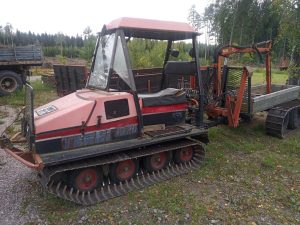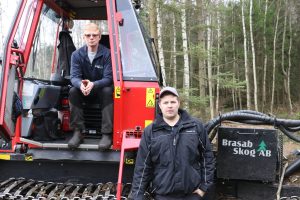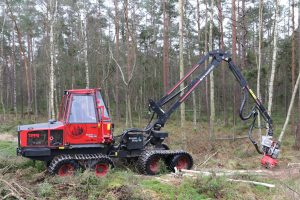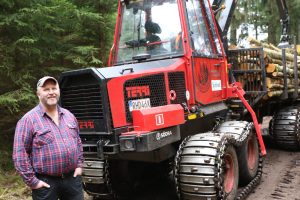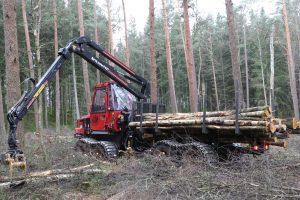We have mainly written about big machines here at NordicWoodJournal.com. Machines like John Deere 1910, Komatsu 895, and Rottne F20. Sturdy, efficient, and impressive machines. But if you are logging in very wet areas and soft soil, they may not always be so impressive. Then you will need another type or size of the machine – like a Terri.
Terri
The first Terri, Terri 30, was built by Finnish Valmet in 1972. Through the years it has been used for different purposes, not only forestry. E.g., being a polar expedition vehicle on the south pole. In 1995 Terri became Swedish as the Swedish importer took over the manufacturing from Valmet who wanted to focus on other machines. Since then, different owners have brought the concept forward to today.
You can read the history in detail here.
Originally a track machine
Terri is probably most famous for its tracked machines. But since 2017, Terri also offers wheeled machines meaning that they widened the target group. However, we are still talking about lightweight machines suitable for young thinning and wetlands.
I decided to have a closer look at Terri, so I contacted the south Swedish logging company Brasab Skog AB which has all sizes of machines in the fleet including one Terri group (harvester and forwarder). One of the owners (one of three), Martin Olsson, accompanied me to the machines operating on two different sites.
Both the harvester and the forwarder in this case are wheeled machines, but they were both equipped with tracks to cope with the soft soil they were operating in.
Terri 3HW harvester
“3” is a version number. “HW” stands for “Harvester–Wheeled”.
The harvester I visited is approx. 6 months old and is equipped with a Log Max 2000 harvester head. It was operating in a very wet area next to a recently harvested clear-cut. The trees were crooked and not the easiest ones to process but the machine, and the operator did a good job as you can see in the film below. The timber produced was pulpwood and pallet timber.
Some facts about the machines
You will find all the facts about those two machines and the rest of the Terri range on the Terri homepage. But here are some basic facts about the Terri 3HW:
Engine: CAT 3.6 diesel. 4 cylinders. 75 hp (55,4 kW). Torque 424 Nm/1.200 rpm.
Transmission: Fully hydraulic. 3 gears and reverse. Wheel dimensions 500/50 x 17.
Electrical system: 24V.
Crane: Mowi P40/P40T. Lifting torque 37 kNm. Reach 6,2/7,5 meters (20,3/24,6 ft).
Harvester head: Log Max 2000T. Max opening 330 millimeters (13 in).
Machine weight: 7,5 metric tons
Length, standard: 5,8 meters (19 ft).
Width: 2,05 meters (6,7 ft)
Ground clearance: 0,7 meters (2,3 ft).
And here is a film with the harvester:
Terri 3FW forwarder
Here “FW” stands for “Forwarder-Wheeled” and “3” is the version, just like for the harvester.
The forwarder, which was one year old, was operating on a small clear-cut on pure peatland. It was very soft, and the operator Glenn didn’t dare to take full loads. Luckily for him, the forwarding distance was short.
As mentioned above, you will find all information about the Terri range including the 3FW forwarder, but there are some facts also about the Terri 3FW:
Engine: CAT 3.6 diesel. 75 hp (55,4 kW). 4 cylinders. Torque 424 Nm at 1.200 rpm.
Transmission: Fully hydraulic. 3 gears and reverse. Wheel dimensions 500/50 x 17.
Electrical system 24V.
Crane: Mowi P40/P40T. Lifting torque 37 kNm. Reach 6,2/7,5 meters (20,3/24,6 ft).
Weight: 6,1 metric tons
Loading capacity: 6 metric tons
Length, standard: 6,6 – 7,2 meters (21,7 – 23,6 ft)
Width: 2,05 meters (6,7 ft)
Ground clearance: 0,7 meters (2,3 ft)
And here is a film of the forwarder:
Films and photos: Per Jonsson






